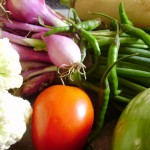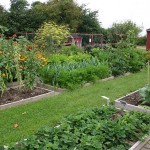Successful food growing is as much about time spent in the kitchen as in the veg patch and at this time of the year that point is usually in sharp focus. The garden is at its most productive and you’re unlikely to be able to use all of its bounty straight away. So, storing the produce, or finding some way of processing it, is as important as growing the food in the first place.
Sometimes, processing jobs can be mercifully straightforward—for example, a crop of garlic can be turned in to a garlic braid that will hang happily in the kitchen for about 5 months in about 15 minutes. Squashes and pumpkins make their way from the veg patch to the top of the dresser in the kitchen where thanks to their thick skins they will store until next spring. A colander-full of French beans just needs a dunk in some boiling water to blanch them before you bag them up for the freezer. There are plenty of beans still remaining on the plants to be grazed on as required in the month ahead. But these freezer-bound ones will be particularly appreciated after Christmas when the bean plants are long since composted.
Other processing jobs require more of a time investment. Late summer and autumn weekends generally see me spending entire days in the kitchen surrounded by boiling pans, bubbling pots and chopping boards laden down with vegetables. There are times when I find this somewhat of a chore, but other times when I can get myself in to the right frame of mind. August means glut territory for tomatoes and there are lots of options to process them. I generally sun-dry one batch of the much-coveted sungold variety in a very low oven overnight and then put them in a sterilized kilner jar, covered with olive oil. Another batch go in a tray in to a hot oven with some garlic, seasoning and rosemary, get cooked for 30 minutes and are then blitzed to turn them in to passata (which will emerge from the freezer later in the year to make a pizza or pasta). And finally I use 1.5kg of bigger tomatoes to make a big batch of tomato ketchup (see recipe below) which is a great way to make a relatively small amount of delicious tomatoes go a very long way indeed.
I am a glutton for punishment, so this month I am also making: jars of beetroot marmalade (great to accompany meats or in sandwiches); zingy cucumber and onion pickle; and a big batch of gut-friendly kimchi (fermented cabbage, carrot and beetroot). I could have put the various completed jars straight in to the cupboard, but I left them on the counter for a few days so I could enjoy looking at them for a little while first. It’s hard work, but these are some of the growing year’s most satisfying moments.
Things to do this August
To-Do: Green manures (mustard, buckwheat, radish, rye, alfalfa, clover and vetches) are plants which are grown specifically to improve soil fertility and useful at times when beds are empty (as is often the case in August). Grow directly in the bed and then cut down and dig in to the soil. Give pumpkins plenty of water and apply a high-potash liquid feed. Nip out the growing points to encourage the fruits to swell. Net brassicas to keep butterflies and the cabbage moth away (and check undersides of leaves regularly for caterpillars). Keep watering – mulch around plants to retain moisture.
Sow: Continue succession sowings of lettuce, oriental greens and other interesting salad bowl leaves. Sow spring cabbage, red cabbage, winter spinach, salad onions (in polytunnel for spring crop), autumn salad mix, endive, parsley.
Harvest: Pick Beetroot regularly as they reach the size you require—if left to grow too large they will loose their tenderness. They can be stored in sand. Continue to harvest tomatoes, carrots, cabbage, cauliflower, peas, broad beans, french and runner beans, salad leaves, radish, turnip, potato, onions, peppers and chilli-peppers, aubergine, globe artichoke, courgettes, cucumber, gooseberries, raspberries and currants.
Recipe of the Month
Tomato Ketchup
Rory O’Connell has been a great friend to GIY over the years, and some of his wonderful recipes appear in our book Grow Cook Eat. This is his recipe for Tomato Ketchup—it’s absolutely delicious and far healthier than the shop bought equivalent. Makes 6 × 225ml bottles.
Ingredients:
- 1.6kg tomatoes, peeled and chopped
- 450g eating apples, peeled, cored and chopped (weigh after peeling and coring)
- 450g onions, chopped
- 600g sugar
- 450ml cider vinegar
- 1 level tablespoon sea salt
- ¼ teaspoon cayenne
- 6 black peppercorns
- 6 allspice/ pimento berries
- 6 cloves
Directions:
Place all the ingredients in a stainless-steel saucepan. Bring to a boil and summer for about 1 hour, stirring regularly to avoid sticking, until it has the consistency of ketchup. Leave to cool for 4–5 minutes, then blend to a smooth puree. If the consistency is a bit thin, return to the saucepan and cook to reduce further. Remember: it will thicken as it cools. Pour into sterilized glass bottles and store in a cool, dry place, for 3 months or more.
Things to do this Month
How to Harvest Sunflower Seeds
If you grew sunflowers this year, you will most likely have been enjoying the beauty of the flowers in the last few weeks. Don’t forget they also now provide a wonderful, protein-rich food bounty—the flowers are hiding hundreds of sunflower seeds which you can harvest and store to sprinkle on your porridge. The key to successful harvesting of the seeds is to get the flower head dry—this can be done outside (if the weather’s fine and sunny) or else by removing the head and drying it indoors.
Wait until about half the yellow petals have dropped and the flower is wilting. Have a look at the seeds—you will see them lurking in behind the black florets. Remove the head leaving 30cm of stem attached to the head. Tie a paper bag over the head, and fasten it loosely with some string or twine. Don’t use plastic—you want air to be able to circulate inside the bag. Hang the head upside down indoors somewhere dry and sunny for about a week. I hang them in the greenhouse. The bag captures any seeds that fall off. The seeds should come away easily when dry, simply by rubbing them. Wash the seeds, then dry them well and store in an airtight container. If you can, be generous, and leave some of the sunflowers in situ for birds and other wildlife to share the spoils.
Join GIY
By joining GIY you help us to continue the work of supporting people just like you to grow food at home, at school, in the workplace and in the community—this year we will support over 150,000 people and 4,500 community food growing groups and projects. It costs just €35 to join GIY for a year, and to say thanks we will send you a seasonal copy of our supporter’s magazine GROW and some GIY seeds for you to sow each quarter. Join today at www.GIYireland.com.
Michael Kelly is a freelance journalist, author and founder of GIY.
© GIY Ireland 2016—all rights reserved.




